
Please sign in or register
Existing users sign in here
Having trouble signing in?
Contact Customer Support at
[email protected]
or call+852 3175 1913
A women-dominated Olympics is fuelling optimism in increased brand endorsements for women's sport. Campaign explores why marketers who have the foresight to invest in female athletes now will reap the biggest rewards.

Contact Customer Support at
[email protected]
or call+852 3175 1913
Top news, insights and analysis every weekday
Sign up for Campaign Bulletins
Sofia Hernandez, global head of business marketing and commercial partnerships, spoke to Campaign about the importance of agencies.
Trust and predictability are practical tools for navigating complexity, but leaders must be steady, not static, says Edelman's CEO for Hong Kong, Taiwan and Singapore.
With robust retention rates in 2024 and an expanding presence in China, PHD had a league-topping year. But with new business wins on the slow and an impending merger, it remains to be seen how the agency can overcome incoming challenges.
Meta has enhanced its Advantage+ advertising platform with new generative AI tools designed to help advertisers create personalised, brand-consistent ads at scale.